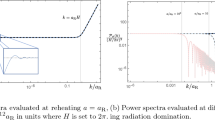Abstract
Effective field theories that manifest UV/IR mode mixing in such a way as to be valid for arbitrarily large volumes, can be used for gravitational, non-black hole events to be accounted for. In formulating such theories with a large number of particle species N, we employ constraints from the muon g − 2, higher-dimensional operator corrections due to the required UV and IR cutoffs as well as the RG evolution in a conventional field-theoretical model in curved space. While in general our bounds on N do reflect N ≃ 1032, a bound motivated by the solution to the hierarchy problem in the alike theories and obtained by the fact that strong gravity has not been seen in the particle collisions, the bound from the muon g −2 turns out to be much stronger, N ≲ 1019. For systems on the verge of gravitational collapse, this bound on N is far too restrictive to allow populating a large gap in entropy between those systems and that of black holes of the same size.
Similar content being viewed by others
References
P. Frampton, S.D.H. Hsu, D. Reeb and T.W. Kephart, What is the entropy of the universe?, Class. Quant. Grav. 26 (2009) 145005 [arXiv:0801.1847] [SPIRES].
R. Horvat, Effective field theory, large number of particle species and holography, Phys. Lett. B 674 (2009) 1 [arXiv:0812.2768] [SPIRES].
A.G. Cohen, D.B. Kaplan and A.E. Nelson, Effective field theory, black holes and the cosmological constant, Phys. Rev. Lett. 82 (1999) 4971 [hep-th/9803132] [SPIRES].
G. ’t Hooft, Dimensional reduction in quantum gravity, gr-qc/9310026 [SPIRES].
D.A. Lowe, J. Polchinski, L. Susskind, L. Thorlacius and J. Uglum, Black hole complementarity versus locality, Phys. Rev. D 52 (1995) 6997 [hep-th/9506138] [SPIRES].
C.-H. Chou and K.-W. Ng, Decaying superheavy dark matter and subgalactic structure of the universe, Phys. Lett. B 594 (2004) 1 [astro-ph/0306437] [SPIRES].
M. Li, A model of holographic dark energy, Phys. Lett. B 603 (2004) 1 [hep-th/0403127] [SPIRES].
R. Horvat, Holography and variable cosmological constant, Phys. Rev. D 70 (2004) 087301 [astro-ph/0404204] [SPIRES].
P.J. Steinhardt, Cosmological challenges for the 21st century, in Critical problems in physics, V.L. Fitch and Dr. R. Marlow eds., Princeton University Press, Princeton U.S.A. (1997).
SDSS collaboration, M. Tegmark et al., Cosmological parameters from SDSS and WMAP, Phys. Rev. D 69 (2004) 103501 [astro-ph/0310723] [SPIRES].
G. Dvali, Black holes and large-N species solution to the hierarchy problem, arXiv:0706.2050 [SPIRES].
G. Dvali and M. Redi, Black hole bound on the number of species and quantum gravity at LHC, Phys. Rev. D 77 (2008) 045027 [arXiv:0710.4344] [SPIRES].
G. Dvali and S.N. Solodukhin, Black hole entropy and gravity cutoff, arXiv:0806.3976 [SPIRES].
G. Dvali and C. Gomez, Quantum information and gravity cutoff in theories with species, Phys. Lett. B 674 (2009) 303 [arXiv:0812.1940] [SPIRES].
G. Dvali and C. Gomez, Strong coupling holography, arXiv:0907.3237 [SPIRES].
N. Arkani-Hamed, S. Dimopoulos and G.R. Dvali, The hierarchy problem and new dimensions at a millimeter, Phys. Lett. B 429 (1998) 263 [hep-ph/9803315] [SPIRES].
C. Cao and Y.-X. Chen, Large extra dimensions and holography, arXiv:0809.4075 [SPIRES].
Muon G-2 collaboration, G.W. Bennett et al., Final report of the muon E821 anomalous magnetic moment measurement at BNL, Phys. Rev. D 73 (2006) 072003 [hep-ex/0602035] [SPIRES].
A. Babic, B. Guberina, R. Horvat and H. Stefančić, Renormalization-group running of the cosmological constant and its implication for the Higgs boson mass in the standard model, Phys. Rev. D 65 (2002) 085002 [hep-ph/0111207] [SPIRES].
B. Guberina, R. Horvat and H. Stefančić, Renormalization-group running of the cosmological constant and the fate of the universe, Phys. Rev. D 67 (2003) 083001 [hep-ph/0211184] [SPIRES].
I.L. Shapiro and J. Solà, Scaling behavior of the cosmological constant: Interface between quantum field theory and cosmology, JHEP 02 (2002) 006 [hep-th/0012227] [SPIRES].
I.L. Shapiro and J. Solà, On the scaling behavior of the cosmological constant and the possible existence of new forces and new light degrees of freedom, Phys. Lett. B 475 (2000) 236 [hep-ph/9910462] [SPIRES].
Author information
Authors and Affiliations
Corresponding author
Rights and permissions
About this article
Cite this article
Horvat, R. Holographic constraint and effective field theories with N-species. J. High Energ. Phys. 2010, 92 (2010). https://doi.org/10.1007/JHEP07(2010)092
Received:
Revised:
Accepted:
Published:
DOI: https://doi.org/10.1007/JHEP07(2010)092




